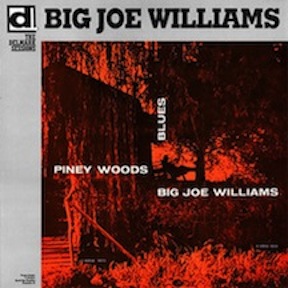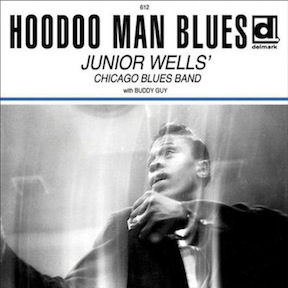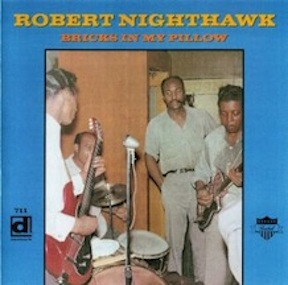BY NIGHT, AND on some weekends, I worked as a volunteer at the Jazz Record Mart, the home of Delmark Records, then at 7 West Grand, just about 6 blocks from our apartment. The proprietor, Bob Koester, was a major force in the jazz and blues communities, selling 78s and rare records to collectors from all over the world, while at the same time using the proceeds from his rare records business to produce and record Chicago’s own home-grown blues players under his Delmark label. Delmark was producing records of south side musicians who had made Chicago famous for the blues, and making them available to a wider audience than the usual race record venues. Many of the artists Koester recorded had never received exposure outside of the black community in Chicago. Though their records were prominent in the juke boxes and record shops on the south and west side of the city, they had never received more substantial distribution. Koester had been a record collector and trader all of his life, and had started Delmark in St. Louis in 1953 to record jazz and blues players in the city. He moved to Chicago in 1958, bought Seymour’s Jazz Mart on West Grand, and ran a specialty record shop on the street floor, and Delmark records in the basement. He was a hard-nosed entrepreneur and a curmudgeon, and didn’t suffer fools kindly. But he knew the music, he knew the business, and he knew the scene. The store employed a number of musicians who packed rare traditional jazz 78s and collections for Koester’s mail order customers in the basement. After a couple of afternoons of college-kid-blues-groupie conversation with Koester, I asked if I could work for him without pay. I would have done anything to hang out, and I knew I was capable of packing records.
A guy named “Apple-Jack” Walroth showed me how to pack the rare records so that they wouldn’t shatter in shipping. I later learned that he was a musician, played blues guitar and was picking up the blues harp from some of the players around Chicago — Little Walter, Shaky Walter Horton (also known as “Mumbles” Horton who had earned the “Shaky” nickname on the basis of his head movement when he played), Jr. Wells and others. Apple Jack made a point of telling me not to take any advice from Charlie Musslewhite, known as “Memphis Charlie”, another harp player who was deemed by Koester to be an excellent blues man, but one of the dimmest and least reliable workers at the store. Big Joe Williams occasionally worked at the store and sometime slept on a cot in the basement. He was a stocky and rumpled man who always looked worried. He had worked with and for Koester since the 50s in St. Louis, and Bob would help him to get gigs playing for coffee houses, small clubs, parties and private gatherings. The blues scene was changing, however, and though there was a solid market for urban blues and younger players, there wasn’t much of a market for the sort of raw country blues that Joe played. He agonized over each date that he had, asking Koester for reassurance that whatever audience it was would appreciate his music, and wouldn’t boo him off the stage. Sometimes he’d practice with his nine-string in a corner of the basement, and took the time to show me how he played “Baby Please Don’t Go.” I was thrilled but also saddened to see what had become of a musician who had so much influence in my life.
Another regular part-timer at the Jazz Record Mart was Chester Burnett, otherwise known as Howlin’ Wolf. He was a huge man, towering above us all at six foot five, and his 300 pound frame could fill a doorway. Generally, Wolf was a quiet man, smoldering and deliberate in everything he did. He was an excellent packer and did his work without speaking. I tried to stay out of his way. I had the sense that like Big Joe, he had very mixed feelings about the humiliation of having to pack records for the few bucks he was getting paid. Like Joe and many other musicians who relied on Bob for work, support, and sometimes a place to stay, his loyalty to Koester was unquestioned. Once a box of remastered Howlin’ Wolf records arrived at the store, sent over by the Chess organization. Both Wolf and Chess stood to make some additional money from the re-issues. We gathered around the turntable and Koester dropped the needle to see how they had remastered Wolf’s classic sides. Some genius had added horns and a tuba to those amazing blues sides, and we were all stunned into disbelief. Wolf calmly took the needle off the record, put the record back in the box, picked up the box, walked outside, raised the box high over his head, and with all the force he could muster, smashed the entire box on a parking meter. As he walked back into the store, leaving the shards of records and the box by the curb, he half-apologized to Koester. “Man, that was dog shit! I just couldn’t take it,” he said, and then walked down the stairs to continue packing records. Koester later explained to me that the Chess brothers were not always kind or fair to their talent.
During the time I was hanging out at the Jazz Record Mart, Koester was producing Jr. Wells’ Hoodoo Man Blues album. He had recorded jazz greats such as George Lewis, Donald Byrd, Jimmy Forrest and Bud Powell, and had supported blues players in both St. Louis and Chicago. Wells, whose actual name was Amos Blakemoor, had stepped into the Muddy Waters band, replacing Little Walter Jacobs when he left the band after his success with Juke and had developed a style of amplified harp that was influenced by Junior Parker, Sonny Boy Williamson and, of course, Little Walter. He stayed with the band for a year, while also working with a band named The Aces. After a stint in the army he returned to recording with his own band and eventually teamed up with Buddy Guy, and became the house band for Teresa’s Lounge. For Koester and Delmark, the Hoodoo Man recording was to be the beginning of a great catalog of contemporary Chicago Blues players that included Magic Sam, J.B. Hutto and the Hawks, Robert Nighthawk, Malachi Thompson, Otis “The Honeydripper” Rush, Roosevelt Sykes and others. Bob would speak with great animation about his plans for Delmark, of course always contingent on finding the funding and doing things on the cheap, and I was sufficiently enamored to volunteer to do anything.
Part of the work for “Hoodoo Man“ was with Stu Black at Sound Studios, part of the work was at Theresa’s lounge at 48th and Indiana, where Junior played regularly, and part of the work was in the basement of the Jazz Record Mart where Koester tirelessly edited the studio tapes, splicing together large sections of various takes. It was all very primitive, and I was amazed that Koester could actually pull one of the best blues records in history out of the chaos. My role was as a hanger-on, but Bob consulted with me in the all-night editing sessions in the basement, seemingly valued my opinion on his editorial decisions, and took me with him to Theresa’s several times, once for a live recording that didn’t work out, and once to negotiate final release arrangements with Junior. Another player in the production of the record was Peter Brown, a young Brit who was more or less the assistant manager of the Jazz Record Mart. Peter had an amazing knowledge of jazz and blues, and had a legendary reputation for being able to identify any 78 jazz or blues record from a single 5-second needle drop. When Koester thought that guitarist Buddy Guy had a contractual conflict playing on the Hoodoo Man Blues record (the Chess brothers again), it was Peter that came up with the pseudonym “Friendly Chap” for the album cover.
The trips to Theresa’s were extraordinary. Theresa Needam had opened her bar in 1949, in a half–flight down basement on Indiana, and had built it into an amazing venue for blues in the heart of the black working class south side community. With the low ceilings and the relative small space, the lounge was in part neighborhood hangout, and in part the anchor for a group of bars and clubs, including Pepper’s Queen Bee, Florence’s, and Ross & McBea that had developed and sustained the Chicago style of urban blues. From the Great Migration to the post World War II era, Chicago had been the destination for blacks migrating north for work and a new life. Many of the players of the day had brought the raw sound of delta blues north with them, had electrified and amplified it, and had turned it into a distinctive sound in the bars and clubs of south and west side Chicago. The market for so-called “race records” in urban markets was booming, but there was very little crossover in terms of performance venues or record distribution outside of the black community. It’s interesting to note, in hindsight, that Koester’s liner notes for “Hoodoo Man” noted that Junior was able to play in a white club and be appreciated by a white audience.
The journey to “T’s” required an L-ride to 47th and Indiana, and a one-and-a-half block walk to the steps descending to the lounge. The walk down the street nearly always involved racial epithets, sneers and impromptu sermons, and most often we were the only white patrons in the club. A string of Christmas lights behind the long wooden bar gave the place a homey feel, and small 4-person tables lined the opposite wall. It was described by some as “funky and friendly,” “slightly dangerous” and as having “unreliable plumbing.” * It was rumored that Theresa had a lost-and-found drawer full of guns that had been left behind by patrons. But it was an intensely intimate venue for blues players, and watching Wells in an electric blue suit fill the low-ceilinged room with the searing phrases of his electrified harp while laughing and joking with the patrons at the tables, I saw a side of the blues that I’d never experienced before. Being one of only three whites within a half-mile, there was some measure of fear involved in making the journey, but at the same time, on a “Blue Monday” at T’s half the musicians in Chicago would sit in. Right in front of me were all of the blues players who had electrified my teen years — Little Walter (whose “My Babe” had been my favorite through-the-wall side), Howlin Wolf (whose “Smokestack Lightning” had stunned me with its swampy power), Muddy Waters (his “Hootchie Cootchie Man” was one of the first blues songs I’d learned to play on guitar), Buddy Guy (whose frantic “First Time I Met the Blues” had tattooed my nervous system ), Big Walter Horton (whose work with Jimmy Rogers on “Easy” had convinced me that I’d never be a harmonica player), Sonny Boy Williamson (whose “Don’t Start Me To Talkin'” became a personal anthem) and Junior Wells — joking and drinking, laughing, and sitting in on sets with one another. For a college kid who lived for the blues, it was a peak experience. The music wasn’t yet a commodity, it was a culture, a lived experience, a context and set of cultural codes shared by working class blacks who would sing with the musicians, empathize with the pain songs, cry when the musicians cried, scream and laugh and dance with the music. T’s was a place where people shared their experiences, listened to the music that narrated their lives and made a common place and a common culture. For me it was the beginning of my understanding of culture as practice.
* Sean Parnell, “Theresa’s Lounge in Memorium”, The Chicago Bar Project, 9/27/2003.






Go cat go!!! I love Big Joe talking to you about Baby Please Don’t Go!!!!! What an experience. Thanks Bob!!!!
Robert, I had nearly forgotten about your time in Chicago. I think I still have some of those blues records, thanks to that same “older brother.”
D.D. in D. C.
Hi Bob, many thanks for mentioning me in your post about Delmark Records 1965.
Thanks for reminding me of the old days in the shipping department !
By the way, it would never be my intention to deprecate Charlie Musselwhite – – –
as I recall I was just warned by ‘the management’ to not use him as a role model for work behavior (smile). Hey, I’m no role model either! I have fond memories of hanging out with Charlie at the Jazz Record Mart, at Bill Chaver’s Old Wells Record Shop, and also listening to blues 78s at Charlie’s apartment in Hyde Park when he lived down that way. Best regards to you!
By the way, please visit my humble blog,
http://jaxpage.wordpress.com/
many thanks.
In regards to the editing of the Hoodoo Man Blues album, my late departed friend Hart McNee was enlisted by Bob Koester to do some of the tape editing / splicing that was required post-session. This was my first exposure to music editing as I watched the razor go across the tape! Job very accurately executed by the way.